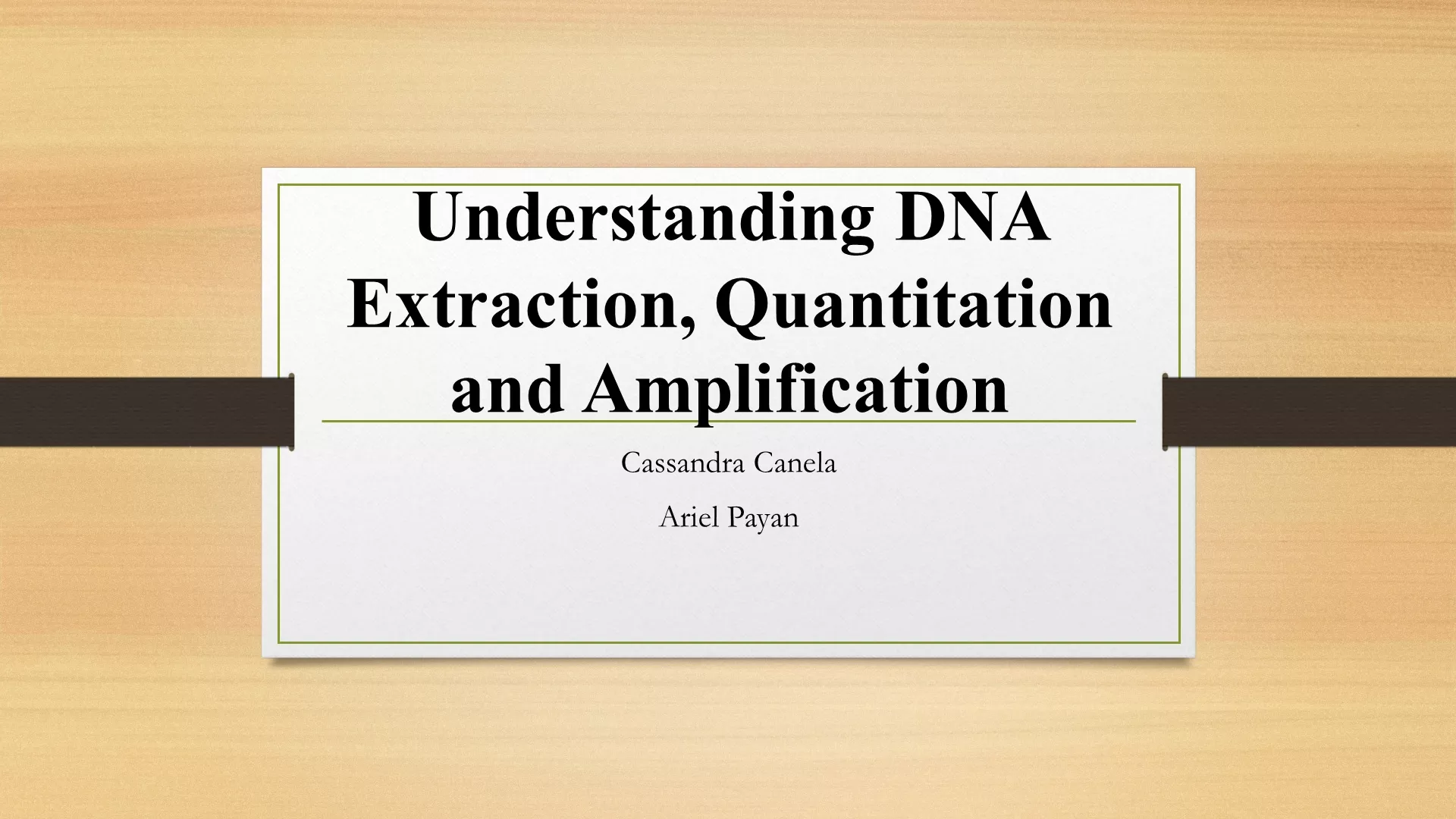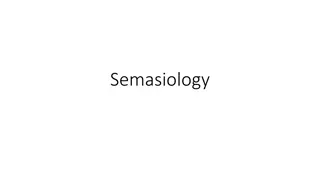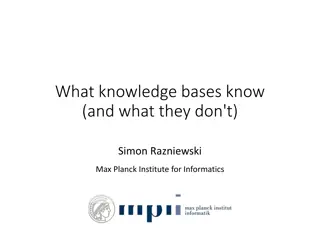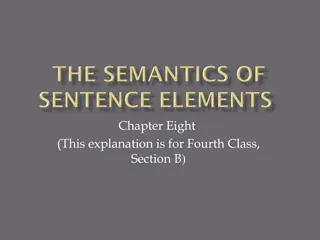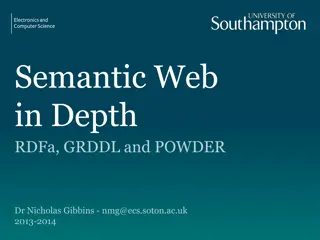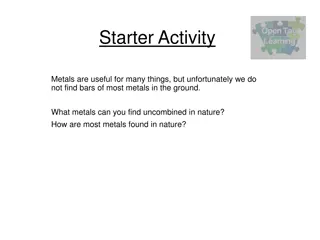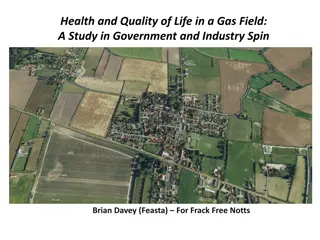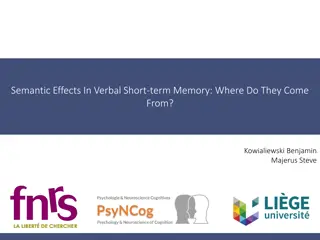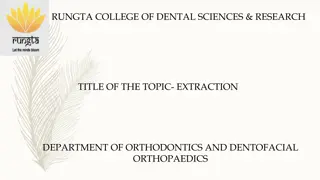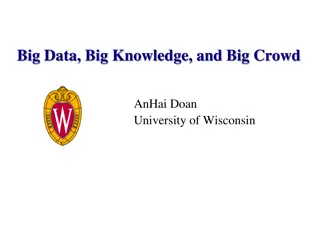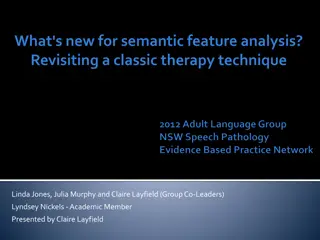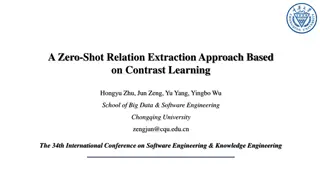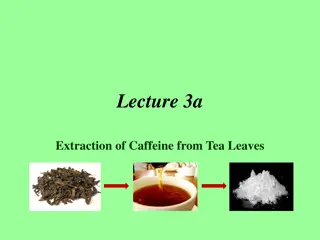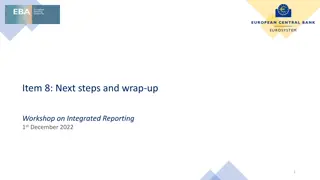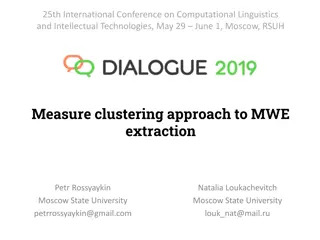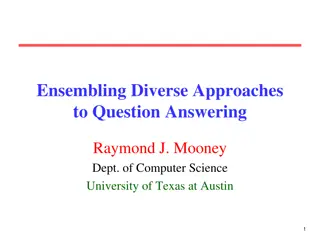Semantic Technologies for Data Management and Knowledge Extraction
An exploration of how semantic technologies facilitate data management, knowledge extraction, and understanding in the realm of big data. Topics covered include semantic graphs, content information extraction, and the impact of semantic models on enhancing data value and relationships. The importance of utilizing semantic technologies to handle issues of data variety, veracity, and integration is highlighted, along with real-world examples showcasing the value of semantic approaches in data analysis and decision-making.
Download Presentation

Please find below an Image/Link to download the presentation.
The content on the website is provided AS IS for your information and personal use only. It may not be sold, licensed, or shared on other websites without obtaining consent from the author.If you encounter any issues during the download, it is possible that the publisher has removed the file from their server.
You are allowed to download the files provided on this website for personal or commercial use, subject to the condition that they are used lawfully. All files are the property of their respective owners.
The content on the website is provided AS IS for your information and personal use only. It may not be sold, licensed, or shared on other websites without obtaining consent from the author.
E N D
Presentation Transcript
Big data e conoscenza: grafi semantici Maria Teresa PAZIENZA a.a. 2017-18
BD e semantica Annotare dati con le rappresentazioni semantiche ad essi associate aiuta a gestire aspetti di eterogeneit (variety) e veridicit (veracity) verificando che non siano violati vincoli semantici. Collegare automaticamente dati ad un modello semantico supporta l integrazione e l interoperabilit tra le informazioni oltre a supportare il reasoning.
Content Information Extraction (IE) systems e BD: estrarre conoscenza da sorgenti testuali - in the web. Problema chiave: superare il problema delle informazioni errare o incomplete trovarte in milioni di possibili candidati del processo di estrazione Soluzione: coinvolgere la semantica usando i constraint ontologici tra fatti candidati per eliminare gli errori.
7 Ways Semantic Technologies Make Data Make Sense aa. 2017-18
As unstructured data piles up, semantic technologies help organizations drive business value through a better understanding of the data they have, its value, and the relationships pieces of information have to each other.
1-Understand The Information Landscape "You can use semantic models to annotate what's in the data and to describe the business meaning of the data. Because a semantic model is a graph representation, it's really much easier to represent data in the way people think about it" said Sean Martin, CTO and founder of Cambridge Semantics.
2-Take Appropriate Action Social media data is far less reliable than many other sources of data. When a signal is misinterpreted, the result may be a regrettable action on the part of an employee or an entire organization.
2-Take Appropriate Action For example, when Scotland held a referendum on whether to secede from the UK in 2014, the Bank of England feared a run on the banks. As part of its risk management strategy, it started to track terms and keywords on Twitter. One morning, there was a dramatic spike on "RBS" -- which seemed to mean the Royal Bank of Scotland. However, the chatter was actually about "RBs," specifically Minnesota Vikings' running backs tweeted about during a football game. "Without a semantic model to understand the context of the data, you can be bombarded by false signals that are a distraction and can make your analysis invalid. Semantic models and technologies like deep learning can help you understand the context of content so you can remove it from the analysis or focus on it,"
3-Improve Productivity "When a recruiter uploads a job description to the system, [he or she] wants to compare it against all external resume databases, bring back those documents, and rank-order them quickly." Large companies may have millions of resumes at their disposal, some of which they have immediate access to and some of which are gathered from job search sites. The goal is to reduce an unwieldy number of resumes to a manageable subset of 25 or 50 relevant ones. Recruiters can then take advantage of machine learning to further narrow or expand the concepts. To allow them to do that effectively, CareerBuilder allows recruiters to see the input the machine used and its reasoning so they can make adjustments as necessary.
4-Enable Smarter Database Queries Database queries, like search, are limited by human thought and bias. What's known about data is encoded into software and database schemas, but the underlying system doesn't understand semantics. When semantic knowledge is built into the database, it's possible to do smarter queries and understand relationships between or among pieces of information that were not evident before.
4-Enable Smarter Database Queries "People have been storing facts in databases and running queries, but you can only look things up that were stored explicitly. With semantics, you can get answers [by] getting the database to do some of the reasoning for you, as well as to answer more complex and interesting questions"
4-Enable Smarter Database Queries Esempio: NBC, a MarkLogic customer, took advantage of semantics when building its Saturday Night Live (SNL) 40th anniversary iPhone app. The goal was to maximize user engagement by anticipating the video clips individual users wanted to see. To do that effectively, it added semantic information to the SNL video clips including who the actors were, which characters they were playing, and the era from which the skit came.
5-Get More From Your Data Lake Organizations are understandably concerned about turning their data lakes into data swamps. Poor quality data leads to substandard analytics and erroneous conclusions. Nevertheless, some organizations are losing control of the meaning and context of their data as it's stored. Semantic models provide a standards-based means of putting the context and meaning back in.
5-Get More From Your Data Lake "One of the things we're able to do with semantics is connect metadata models and describe where the data is to the ETL [extract, transform, and load] data ingestion process so you can create semantic models that describe the flow of data and the transformation of data. Then, you can operationalize that" .
6-Enable Analytics At Scale Traditional business intelligence is labor-intensive. One has to think about the questions up front, what the data warehouse requirements are, the ETL necessary to populate the data warehouse, and the reporting requirements. The entire process is time-consuming. "Graph analytics, the application of semantic models and RDF [Resource Description Framework] graph format, allows you to consider all the entities you care about simultaneously. As an end-user you have random access to it so you're [never limited] by what's been prepared for you. You can keep loading more data in to answer your questions The result is iterative, flexible ad-hoc analysis on the fly.
7-Surface Critical Information Faster Keyword search is a fairly effective way to navigate unstructured data, but its efficiency is affected by the user's ability to select search terms that align with the desired content. The outcome is often an overabundance of results or lack of relevant results. Anything that was not explicitly stated in the search remains hidden. Semantic search is different because it's is not limited to explicit statements. It understands the meaning of information, its context, and its relationship to other pieces of information to deliver more precise results. But, like anything else, semantic technology also has limitations.
7-Surface Critical Information Faster "We found semantic technology is great for certain things or certain types of data that you want to get at, but not everything -- a table in a document, for example. The part of big data that's often neglected is this notion of little data, the data in an organization that is of paramount importance to a firm, so we created a platform that will actually structure unstructured data."
Grafi Semantici Un grafo semantico inteso come una rete di nodi eterogenei e collegamenti annotati rispetto ad una ontologia di dominio. Un grafo semantico o "knowledge graph" una implementazione delle tecniche del semantic web a supporto della rappresentazione della conoscenza Google, Microsoft, Facebook, Cos , per esempio, un grafo semantico una tecnica efficace per organizzare hotels e le relazioni tra hotels cos come con altri concetti (es. prossimit a centri di attrazioni, agli aereoporti, etc.)
Knowledge graph KG wikipedia The Knowledge Graph is a knowledge base used by Google to enhance its search engine's search results with semantic-search information gathered from a wide variety of sources. Knowledge Graph display was added to Google's search engine in 2012, starting in the United States, having been announced on May 16, 2012.It uses a graph database to provide structured and detailed information about the topic in addition to a list of links to other sites. The goal is that users would be able to use this information to resolve their query without having to navigate to other sites and assemble the information themselves. The short summary provided in the knowledge graph is often used as a spoken answer in Google Assistant searches. As of the end of 2016, knowledge graph holds over 70 billion facts.
GOOGLE knowledge graphs aa. 2017-18
Introducing the Knowledge Graph: things, not strings (GOOGLE launch 2012) Search is a lot about discovery. But searching still requires a lot of hard work by you, the user. Take a query like [taj mahal] To a search engine the words [taj mahal] have been just that two words. But we all know that [taj mahal] has a much richer meaning. You might think of one of the world s most beautiful monuments, or a Grammy Award- winning musician, or possibly even a casino in Atlantic City, NJ. Or the nearest Indian restaurant. It s why we ve been working on an intelligent model a graph that understands real-world entities and their relationships to one another: things, not strings
GOOGLE Knowledge graphs The Knowledge Graph enables you to search for things, people or places that Google knows about landmarks, celebrities, cities, sports teams, buildings, geographical features, movies, celestial objects, works of art and more and instantly get information that s relevant to your query. This is a critical first step towards building the next generation of search, which taps into the collective intelligence of the web and understands the world a bit more like people do. Also augmented at a much larger scale because we re focused on comprehensive breadth and depth. It currently contains more than 500 million objects, as well as more than 3.5 billion facts about and relationships between these different objects. And it s tuned based on what people search for, and what we find out on the web.
Knowledge Graph enhances Google Search Find the right thing Get the best summary Go deeper and broader
Find the right thing Language can be ambiguous do you mean Taj Mahal the monument, Or Taj Mahal the musician?
Find the right thing the links to see that particular slice of results: https://3.bp.blogspot.com/-eWJEHSdNVbU/T7PKlBLFF6I/AAAAAAAAJKo/-GmvscoTPJg/s1600/taj%2Bmahal.png This is one way the Knowledge Graph makes Google Search more intelligent your results are more relevant because we understand these entities, and the nuances in their meaning, the way you do.
Get the best summary With the Knowledge Graph, Google can better understand your query, so we can summarize relevant content around that topic, including key facts you re likely to need for that particular thing. For example, if you re looking for Marie Curie, you ll see when she was born and died, but you ll also get details on her education and scientific discoveries
Get the best summary https://4.bp.blogspot.com/-6CZW79UMwyg/T7PKsKaiyyI/AAAAAAAAJK0/yj5a8qKknQg/s2000/marie%2Bcurie.png
Get the best summary The Knowledge Graph also helps us understand the relationships between things. Marie Curie is a person in the Knowledge Graph, and she had two children, one of whom (Irene) also won a Nobel Prize, as well as a husband, Pierre Curie, who claimed a third Nobel Prize for the family. All of these are linked in our graph. It s not just a catalog of objects; it also models all these inter-relationships. It s the intelligence between these different entities that s the key.
Go deeper and broader Knowledge Graph can help you make some unexpected discoveries. You might learn a new fact or new connection that prompts a whole new line of inquiry. Do you know where Matt Groening, the creator of the Simpsons , got the idea for Homer, Marge and Lisa s names? It s a bit of a surprise:
Go deeper and broader https://1.bp.blogspot.com/-CPt7-kfOngo/T7PO0sTFTgI/AAAAAAAAJLw/s-gfrkimFAU/s2000/matt%2Bgroening.png Go deeper and broader
Go deeper and broader We ve always believed that the perfect search engine should understand exactly what you mean and give you back exactly what you want. We can now sometimes help answer your next question before you ve asked it, because the facts we show are informed by what other people have searched for. For example, the information we show for Tom Cruise answers 37 percent of next queries that people ask about him. In fact, some of the most serendipitous discoveries I ve made using the Knowledge Graph are through the magical People also search for feature.
Semantic Graph Un grafo semantico se Il significato del grafo definito ed esposto in un modo aperto e comprensibile dalle macchine Ovvero, se la semantica del grafo parte del grafo stesso o almeno connessa con il grafo Per la gestione di questo aspetto si usano RDF ed OWL, I linguaggi del Semantic Web.
Semantic Graph La maggior parte degli attuali social networks non-semantica, ma relativamente semplice trasformarli in grafi semantici. Si possono utilizzare le FOAF ontology per definire le entit ed I link tra grafi. FOAF sta per friend of a friend ed una semplice ontologia di persone e relazioni sociali. Se una social network collega I suoi dati alla FOAF ontology, ed espone questi link ad altre applicazioni Web, allora anche le altre applicazioni possono capire il significato dei dati nella network in maniera non ambigua. In altre parole diventa un semantic social graph perch la sua semantica visibile ad altre applicazioni DBpedia una rappresentazione strutturata di Wikipedia. La DBpedia knowledge base fornisce classificazioni per 3.22 milioni di oggetti, che in genere rappresentano persone, luoghi, organizzazioni, malattie, specie, lavori, ed attivit creative.
Semantic Graph- KG Nei grafi semantici: le entities sono rappresentate come nodi, gli attributi di ciascuna entit sono label di nodi, e relazioni tra 2 o pi entit sono rappresentate da archi. In aggiunta alle propriet statistiche delle tecniche per l estrazione dei grafi, l identificazione dei grafi semantici incorpora la semantica nella forma di una ontologia e di constraints ontologici definiti sui fatti del grafo semantico per far leva sulle dipendenze tra fatti.
Semantic Graph- KG L dentificazione dei grafi semantici richiede la combinazione di 2 fattori differenti: 1. Gli output statistici ricavati da attivit di information extraction 2. I constraints ontologici derivati dalla semantica dei grafi stessi (knowledge graphs)
Semantic Graph- KG I constraints ontologici possono essere usati come weighted rules e quindi usati come hints /suggerimenti per inferire fatti corretti all interno di un grafo semantico. L identificazone nei grafi semantici richiede l attivazione del reasoning congiuntamente su milioni di estrazioni simultanee, ponendo cos un fattore di scalabilit a molti possibili approcci.
Semantic Graph- KG I sistemi di information extraction usano una collezione di tecniche che operano su features di documenti quali: structural elements (tabelle), lexical patterns (frasi del tipo presidente di ), morphological features (le lettere maiuscole). Ciascun estrattore produce un set differente di outputs, e pu assegnare a ciascun output un valore di confidenza. Il primo passo nel costruire un grafo semantico proprio combinare features ed estrazioni da diversi estrattori.
Semantic Graph- KG La costruzione di grafi semantici un attivit molto sfidente legata alla molteplice interazione tra aspetti collegati a uncertain extraction, coreferences, ontological information and facts in the semantic graph.


